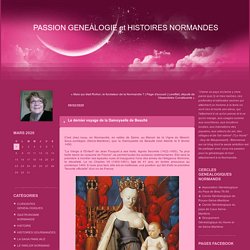

Youtube. Se connecter à Facebook. History Catchers - Histoire. (16) La fin d'une dynastie impériale. Sous les pavés de Paris. Le dernier voyage de la Damoyselle de Beaulté. C'est chez nous, en Normandie, en vallée de Seine, au Manoir de la Vigne du Mesnil-Sous-Jumièges (Seine-Maritime), que la Damoyselle de Beaulté s'est éteinte le 9 février 1450.

"La Vierge à l'Enfant" de Jean Fouquet a ses traits. Agnès Seurelle (1422-1450), "la plus belle dame du royaume de France", se permet toutes les audaces vestimentaires. Elle sera la première à montrer ses épaules nues et inaugurera l'une des armes de l'élégance féminine, le décolleté. Le roi Charles VII (1403-1461), âgé de 41 ans, en tombe amoureux au printemps 1443. 6 mois plus tard, elle est sa maîtresse, une position qui fait d'elle la première "favorite officielle" d'un roi de France.
"La Vierge à l'Enfant", tableau de J.
Histony. Histoire revisitée. Download 91,000 Historic Maps from the Massive David Rumsey Map Collection. Three years ago, we highlighted one of the most comprehensive map collections in existence, the David Rumsey Map Collection, then newly moved to Stanford University.

The Rumsey Collection, we wrote then, “contains a seemingly inexhaustible supply of cartographic images”—justifiable hyperbole, considering the amount of time it would take any one person to absorb the over 150,000 physical artifacts Rumsey has amassed in one place. By 2016, Rumsey had made almost half the collection—over 67,000 images—freely available in a digital archive that has been growing since 1996. Each entry features high-resolution scans for specialists (you can download them for free) and more manageable image sizes for enthusiasts; a wealth of data about provenance and historical context; and digital, user-friendly tools that use crowd-sourcing to measure the accuracy of antiquated maps against GPS renderings. To make this document even more compelling, it contains its own bibliography. Related Content: The History of Cartography, “the Most Ambitious Overview of Map Making Ever Undertaken," Is Free Online.
“Cartography was not born full-fledged as a science or even an art,” wrote map historian Lloyd Brown in 1949.

“It evolved slowly and painfully from obscure origins.” Many ancient maps made no attempt to reproduce actual geography but served as abstract visual representations of political or theological concepts. Written geography has an ancient pedigree, usually traced back to the Greeks and Phoenicians and the Roman historian Strabo. But the making of visual approximations of the world seemed of little interest until later in world history. As “mediators between an inner mental world and an outer physical world”—in the words of historian J.B. Harley’s definition occurs in the first chapter of Volume One of The History of Cartography, a massive six-volume, multi-author work tracing map making from prehistoric times up to the twentieth century; “the most ambitious overview of map making ever undertaken,” Edward Rothstein writes at The New York Times.
Related Content: Ancient Maps that Changed the World: See World Maps from Ancient Greece, Babylon, Rome, and the Islamic World. One of the greatest challenges for writers and greatest joys for readers of fantasy and science fiction is what we call “world building,” the art of creating cities, countries, continents, planets, galaxies, and whole universes to people with warring factions and nomadic truth seekers.

Such writing is the natural offspring of the Medieval travelogue, a genre once taken not as fantasy but fact, when sailors, crusaders, pilgrims, merchants, and mercenaries set out to chart, trade for, and convert, and conquer the world, and returned home with outlandish tales of glittering empires and people with faces in their chests or hopping around on a single foot so big they could use it to shade themselves. In the Western tradition, we can trace world mapmaking all the way back to 6th century B.C.E., Pre-Socratic thinker Anaximander, student of Thales, whom Aristotle regarded as the first Greek philosopher.
You’ll note that Eratosthenes drew primarily on Anaximander’s description of the world. Les morts EPIQUES de l'Histoire - Nota bene #35.
Fantômes du passé. APOCALYPSE : Mathieu Kassovitz, Costelle, Clarke On n'est pas couché 29 mars 2014 #ONPC. NI DIEU NI MAÎTRE, UNE HISTOIRE DE L'ANARCHISME. Congrès Solvay. J'ai changé (ft. Macron, Philippe, Poirson) Charles MARVILLE - le détail dans la... - John d'Orbigny Immobilier.